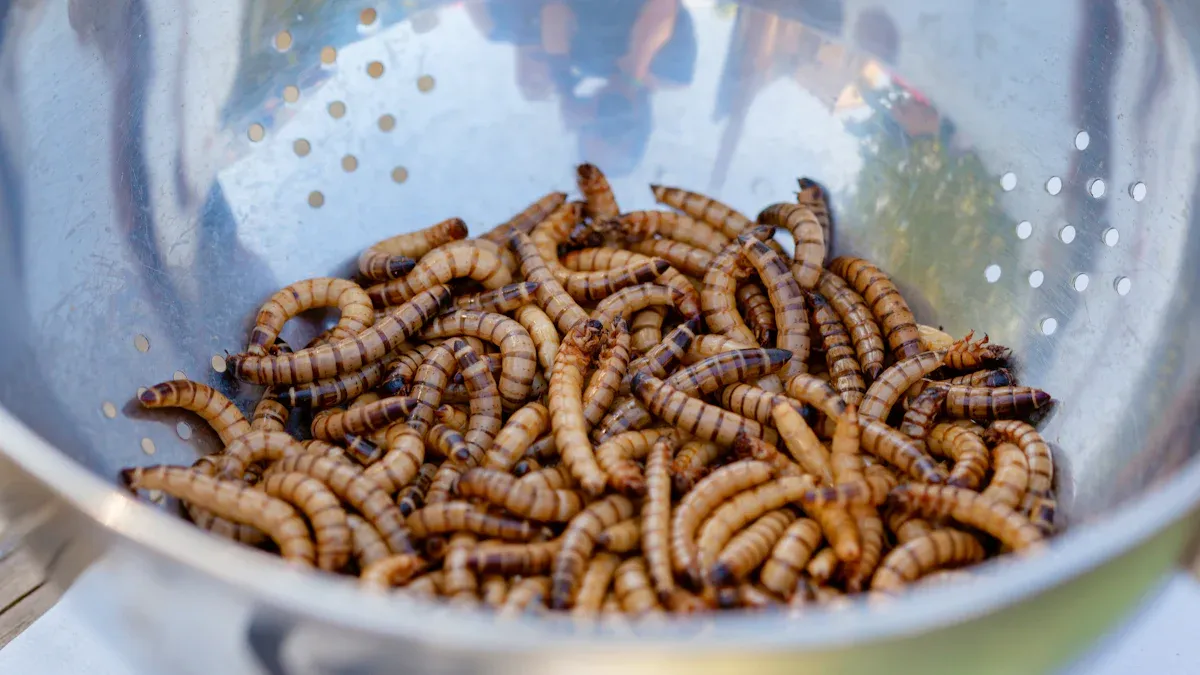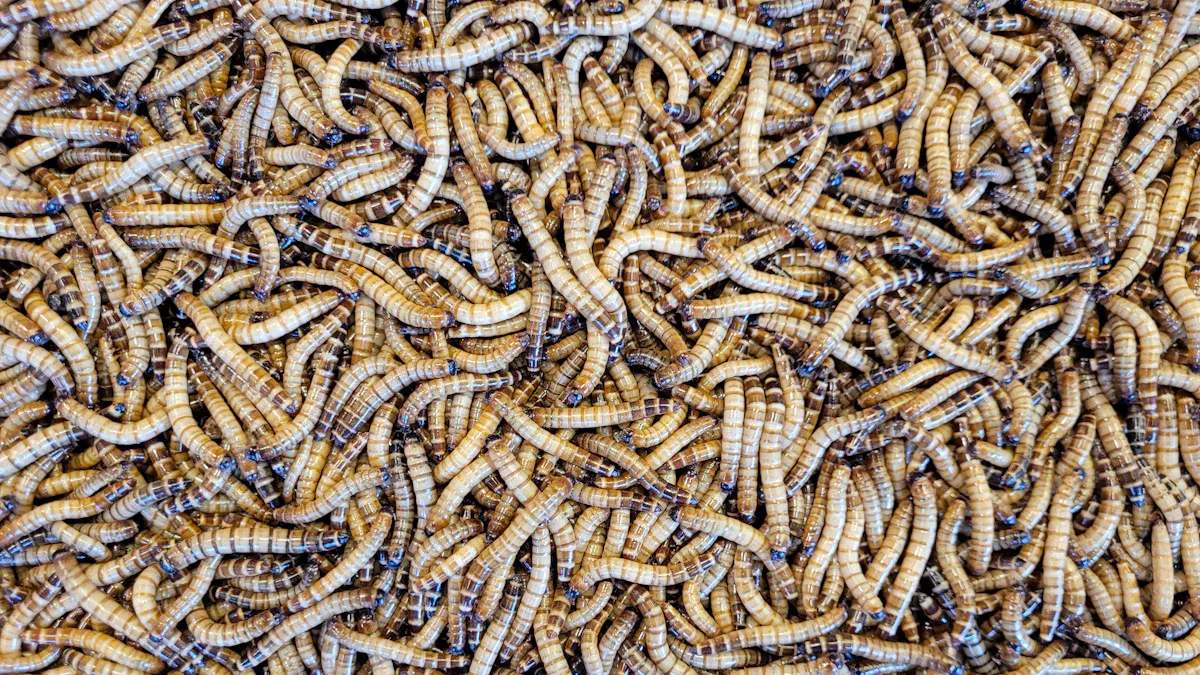
Have you ever wondered what makes freeze dried mealworms such a popular choice for feeding animals? These are the dried larvae of the mealworm beetle, preserved through a special freeze-drying process. This method locks in nutrients while removing moisture, giving them a long shelf life. Compared to fresh mealworms, they pack a punch nutritionally.
| Nutrient | Fresh Mealworms | Dried Mealworms |
|---|---|---|
| Protein | 20% | 53% |
| Fat | 13% | 28% |
| Fiber | 2% | 6% |
| Moisture | 62% | 5% |
With their high protein content and essential nutrients, freeze dried mealworms are a convenient and healthy treat for birds, reptiles, and even fish. They’re easy to store and ready to use whenever your pets or backyard wildlife need a boost.
Key Takeaways
- Freeze dried mealworms are healthy, with 53% protein and vitamins. They are great for birds, reptiles, and fish.
- Freeze-drying keeps nutrients better than regular drying. This helps pets stay healthy.
- These mealworms are simple to store and last a long time. You don’t need a fridge to keep them fresh.
How Freeze Dried Mealworms Are Made
The Freeze-Drying Process
Have you ever wondered how freeze dried mealworms are made? The process starts by freezing fresh mealworms at extremely low temperatures. This step locks in their nutrients and natural structure. Once frozen, the mealworms go through a vacuum chamber where the moisture is removed. Instead of melting, the ice turns directly into vapor through a process called sublimation. This leaves the mealworms dry, light, and ready to store for long periods.
Freeze drying is different from other methods like dehydrating. It uses no heat, so the mealworms keep more of their nutrients. For example, freeze drying retains higher levels of ascorbic acid (vitamin C) compared to dehydrating, which can cause nutrient loss due to heat.
| Method | Nutrient | Retention Level |
|---|---|---|
| Freeze Drying | Ascorbic Acid | Higher retention |
| Dehydrating | Ascorbic Acid | Some loss due to heat |
Advantages of Freeze Drying for Preservation
Freeze drying has some amazing benefits when it comes to preserving mealworms. It keeps up to 97% of sensitive nutrients like vitamin C and B vitamins. Traditional drying methods often lose these nutrients because of heat exposure. Freeze drying also keeps the original flavor and texture of the mealworms. The result? A product that’s light, crispy, and much closer to its fresh state. In contrast, traditionally dried mealworms can feel dense and tough.
This method also makes freeze dried mealworms easy to store. They don’t need refrigeration and have a long shelf life. You can keep them on hand for whenever your pets or backyard wildlife need a nutritious treat.
Nutritional Benefits of Freeze Dried Mealworms

Protein Content and Essential Nutrients
Freeze dried mealworms are a powerhouse of nutrition, especially when it comes to protein. Did you know they contain an impressive 53% protein? This makes them an excellent choice for animals that need a protein boost. Protein plays a vital role in keeping animals healthy. It helps repair and regenerate cells, speeds up wound healing, and strengthens the immune system by aiding antibody production.
But that’s not all. These mealworms are packed with essential nutrients that support animal growth and overall health. They’re rich in amino acids, which are the building blocks of protein. They also provide healthy fats, fiber, and a range of vitamins like B12, niacin, and riboflavin. Minerals such as zinc and magnesium add even more value. These nutrients make freeze dried mealworms a superior option compared to many other feeds.
Comparison to Other Animal Feed Options
When you compare freeze dried mealworms to other common animal feeds like crickets or pellets, they stand out in several ways. Mealworms have a high feed conversion efficiency, meaning they provide more nutrition with less waste. They also use nitrogen more efficiently than traditional livestock, making them a sustainable protein source.
Nutritionally, mealworms are on par with crickets and even surpass some pellet-based feeds. They offer all essential amino acids, which many other feeds lack. Plus, their natural diet of grains and vegetables enhances their nutritional profile. If you’re looking for a feed that’s both nutritious and eco-friendly, freeze dried mealworms are hard to beat.
Common Uses of Freeze Dried Mealworms
Feeding Birds
If you enjoy birdwatching, freeze dried mealworms are a fantastic way to attract a variety of feathered friends to your yard. These mealworms are packed with protein, which is especially important during nesting season when birds need extra energy to feed their young. You’ll notice species like bluebirds and song sparrows flocking to your feeders for this nutritious snack.
Here’s a list of birds that benefit most from adding mealworms to their diet:
- Song Sparrows
- Chickadees
- Nuthatches
- Wrens
- Towhees
- Juncos
- Jays
- Woodpeckers
- Varied Thrush
- Bluebirds
- American Robins
- Hermit Thrushes
Freeze dried mealworms are also convenient. Unlike live mealworms, they don’t require refrigeration or special care. Just sprinkle them in your feeder, and watch the birds come to you!
Reptile and Amphibian Diets
Reptiles and amphibians love freeze dried mealworms too! They’re a great source of protein and essential amino acids, which help keep these animals healthy. Popular pets like geckos, bearded dragons, and chameleons thrive on them. Even aquatic amphibians can benefit from this nutritious treat.
To make the most of mealworms in your reptile’s diet, follow these tips:
- Dust them with calcium and vitamin D3 supplements before feeding.
- Offer them as a treat 2-3 times a week, not as a main food source.
- Keep their diet varied to ensure balanced nutrition.
Mealworms are easy to store and serve, making them a hassle-free addition to your pet’s feeding routine.
Use for Small Mammals and Fish
Small mammals and fish also enjoy freeze dried mealworms. They’re an excellent source of protein and amino acids, which support growth and overall health. Hedgehogs, wild birds, pet poultry, and fish all benefit from this convenient food option.
| Benefit | Description |
|---|---|
| High Protein Source | Essential for growth and health in small mammals and fish. |
| Essential Amino Acids | Vital for various bodily functions. |
| Convenient Alternative | Easier to store and serve compared to live mealworms. |
For fish, freeze dried mealworms are a safe and economical choice. They don’t contain chemicals or artificial ingredients, and they’re easy to store without refrigeration. Whether you’re feeding your goldfish or a hedgehog, these mealworms are a reliable option.
Addressing Concerns About Freeze Dried Mealworms
Safety for Animals
You might wonder if freeze dried mealworms are safe for your pets or backyard wildlife. Generally, they are safe, but there are a few things to keep in mind. Some animals, like humans, can have allergies to mealworms. If you’re allergic to shrimp, you might also react to mealworms. Allergies can occur due to proteins in the mealworms or even molds that might be present.
Another concern is the potential for pathogens. Mealworms can carry microbes in their gut, which may remain even after processing. Studies have found high levels of bacteria in some freeze dried mealworms. To address this, producers take steps like boiling the mealworms for three minutes, draining them, and removing any damaged ones. These measures help ensure the mealworms are clean and safe for animals. Plus, research shows that feeding freeze dried mealworm powder to rats caused no adverse effects, which is reassuring for pet owners.
Nutritional Retention After Freeze Drying
Freeze drying is a fantastic way to preserve the nutrients in mealworms. This process locks in their high protein content and essential amino acids, which are crucial for your pets’ health. Unlike other drying methods, freeze drying doesn’t use heat, so the mealworms retain more of their original nutritional value. This makes them an excellent choice for animals that need a protein-rich diet. Whether you’re feeding birds, reptiles, or fish, you can trust that freeze dried mealworms provide the nutrients they need to thrive.
Environmental Considerations
If you’re looking for an eco-friendly animal feed, freeze dried mealworms are a great option. Producing mealworms requires much less land and water compared to traditional livestock. For example, the water footprint of mealworms is 4341 m³ per edible ton, which is 3.5 times lower than beef. They also produce significantly fewer greenhouse gas emissions.
Here’s a quick comparison:
| Metric | Mealworms | Beef | Chicken |
|---|---|---|---|
| Land Area Required | Much less | Higher | Moderate |
| Greenhouse Gas Emissions | Significantly lower | Higher | Lower |
| Water Footprint (m³/t) | 4341 | 15000 | Comparable |
By choosing freeze dried mealworms, you’re not just giving your pets a nutritious treat—you’re also making a sustainable choice for the planet.
Freeze dried mealworms are a versatile and nutritious option for feeding pets and wildlife. They’re packed with protein and essential nutrients, making them ideal for birds, reptiles, and fish. Their long shelf life and easy storage add convenience, while their sustainable production makes them a smart choice. Why not give them a try?
FAQ
Are freeze dried mealworms better than live mealworms?
Yes! Freeze dried mealworms are easier to store, last longer, and retain nutrients. Plus, you don’t have to deal with wriggling bugs! 🐛
How should I store freeze dried mealworms?
Keep them in a cool, dry place. Reseal the bag tightly after each use. Proper storage ensures freshness and prevents moisture buildup.
Can I feed freeze dried mealworms to baby animals?
Absolutely! They’re safe for baby birds, reptiles, and fish. Just soak them in water first to soften them for easier digestion.
Tip: Always check with your vet for specific dietary needs of young pets.


